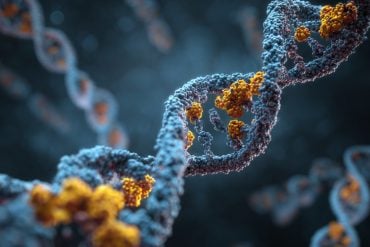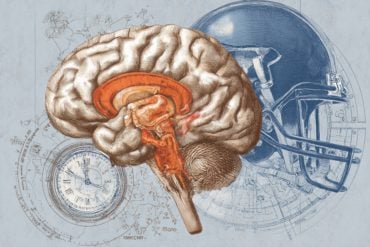Summary: Alcohol use disorder (AUD) disrupts cognitive flexibility, crucial for learning and adapting to change. New research reveals that chronic alcohol exposure alters the firing patterns of cholinergic interneurons (CINs), key neurons in the brain’s striatum that regulate dopamine and influence reward-driven learning.
Normally, CINs fire in a burst-pause pattern vital for unlearning old behaviors and adopting new ones, but alcohol exposure shortens and weakens these pauses, impairing adaptability. The findings highlight potential therapeutic targets for treating AUD-related cognitive impairments and other neurological disorders.
Key Facts:
- CIN Disruption: Chronic alcohol use disrupts CIN burst-pause firing, crucial for reversal learning.
- Acetylcholine’s Role: CINs regulate acetylcholine, affecting adaptability and unlearning outdated behaviors.
- Therapeutic Potential: Findings suggest CIN-targeted treatments may address cognitive deficits in AUD.
Source: Texas A&M
Alcohol use disorder (AUD) affects about 400 million people worldwide and is a leading cause of serious illnesses such as cancer, cardiovascular disease, liver disease and stroke.
Beyond these physical impacts, AUD profoundly disrupts brain functions critical for learning, memory and adaptability—key elements of cognitive flexibility.
Now, researchers at the Texas A&M University College of Medicine have shed new light on how chronic alcohol use alters brain signaling pathways, specifically focusing on how it impairs cognitive flexibility.
Their findings, recently published in Science Advances, demonstrate the significant role of cholinergic interneurons (CINs) in this process.
Zhenbo Huang, PhD, an associate research scientist in the laboratory of Jun Wang, MD, PhD, and colleagues have demonstrated that alcohol disrupts the brain’s ability to adapt by altering the burst-pause firing patterns of CINs—specialized neurons that release acetylcholine, a key neurotransmitter.
CINs are critical gatekeepers in the brain’s striatum, influencing reward-driven learning and motivation by modulating dopamine signaling.
“Dopamine neurons drive the brain’s reward system, while CINs act as the gatekeepers, filtering stimuli that activate these neurons,” said Wang, an associate professor at the Texas A&M College of Medicine.
Using advanced tools such as optogenetics, which uses light to control cells, the researchers uncovered that stimulating CINs in animal models of chronic alcohol exposure produced an altered firing pattern compared to models without chronic alcohol exposure.
Normally, CINs fire in a “burst-pause” pattern: a quick burst of activity followed by a pause, which is essential for learning new behaviors and adapting to change.
However, in alcohol-exposed models, this firing pattern was significantly disrupted, with shorter and weaker pauses, impairing critical learning process such as reversal leaning.
“Reversal learning is a cornerstone of cognitive flexibility,” Wang explained. “It allows individuals to unlearn behaviors when rules or circumstances change—a process heavily reliant on acetylcholine signaling.”
By combining optogenetics—which uses light to control CIN activity—and fiber photometry—which involves genetically engineered biosensors to detect real-time release of acetylcholine while subjects perform tasks—the team discovered distinct roles for different CIN firing phases.
The “burst” phase, which increases acetylcholine release from CINs, aids extinction learning—where old behaviors are unlearned.
The “pause” phase, on the other hand, which causes a dip in acetylcholine release from the CINs, is crucial for reversal learning, where new behaviors replace outdated ones.
This groundbreaking research reveals how alcohol undermines these mechanisms, offering new insights into the broader effects of AUD. Importantly, the findings suggest potential therapeutic targets for addressing cognitive impairments associated with AUD.
“The burst and pause dynamics of CINs are critical for behavioral adaptability,” Wang said.
“This study highlights their unique roles and lays the groundwork for exploring how similar mechanisms might influence conditions beyond addiction, including aging and neurodegenerative diseases.”
The Wang team continues to explore how CIN dynamics impact brain health, aiming to translate their discoveries into innovative treatments for a variety of brain disorders.
Funding: Their research is funded by the National Institute on Alcohol Abuse and Alcoholism (NIAAA)/NIH.
About this AUD and cognition research news
Author: Darren Benson
Source: Texas A&M
Contact: Darren Benson – Texas A&M
Image: The image is credited to Neuroscience News
Original Research: Open access.
“Dynamic responses of striatal cholinergic interneurons control behavioral flexibility” by Zhenbo Huang et al. Science Advances
Abstract
Dynamic responses of striatal cholinergic interneurons control behavioral flexibility
Striatal cholinergic interneurons (CINs) are key to regulating behavioral flexibility, involving both extinguishing learned actions and adopting new ones. However, the mechanisms driving these processes remain elusive.
In this study, we initially demonstrate that chronic alcohol consumption disrupts the burst-pause dynamics of CINs and impairs behavioral flexibility.
We next aimed to elucidate the mechanisms by which CIN dynamics control behavioral flexibility. We found that extinction learning enhances acetylcholine (ACh) release and that mimicking this enhancement through optogenetic induction of CIN burst firing accelerates the extinction process.
In addition, we demonstrate that disrupting CIN pauses via continuous optogenetic stimulation reversibly impairs the updating of goal-directed behaviors.
Overall, we demonstrate that CIN burst firing, which increases ACh release, promotes extinction learning, aiding the extinguishment of learned behaviors. Conversely, CIN firing pauses, which lead to ACh dips, are crucial for reversal learning, facilitating the adaptation of new actions.
These findings shed light on how CIN dynamics regulate behavioral flexibility.







